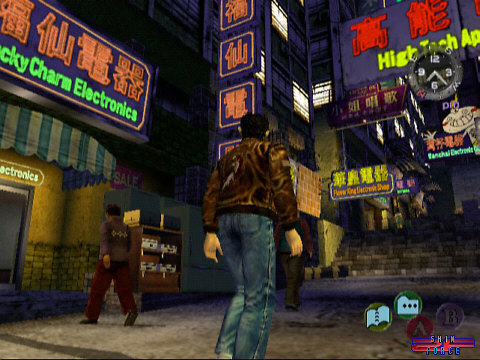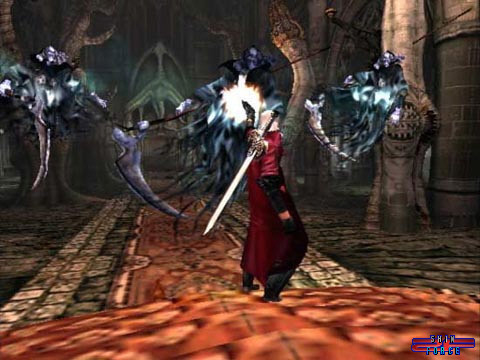> Out of the Dreamcast and Playstation 2, which console is the most capable,
graphically speaking? I noticed that many Playstation 2 fanboys go as far
as to compare modern Playstation 2 games to 3-4 year old Dreamcast games
in a desperate and somehow "fair" attempt to prove that their beloved PS2
is a far more powerful console by comparison... when in reality nothing
could be further from the truth. What a joke. Compare any PS2 game that
came out in 2001 to the critically acclaimed Shenmue
2, and then dare to claim that the PS2 is a vastly superior
console and that the DC belongs in the dark ages. In the spirit of fairness
we should confront the truth instead of running away from it: the PS2 has
more raw processing power and greater bandwidth, which naturally means
it can shift more polygons, but the DC has twice as much video RAM (8MB)
compared to that of the PS2 (4MB), allowing for far more detailed texture
mapping. When it comes to pushing polygons (quadrangular or triangular
3D building blocks in the case of the DC), the PS2 is hands-down more powerful,
but when it comes to textures, the DC rules the console roost. The amount
of Video RAM itself isn't the only thing that contributes to the PS2's
poorer texture capabilities: while the DC can compress and decompress textures
on-the-fly (in real-time) at a 5:1 (and sometimes even an 8:1) ratio when
the time comes to wrap those textures around polygon models thanks to the
wonders of on-board memory compression, textures must be uncompressed before
reaching the PS2's video RAM cache on the console's Graphics Synthesizer
(where
all
the rendering takes place). Textures can be streamed (sent more than once
per frame which is what the PS2 was designed to do), but the PS2 is always
limited to 4 MBs of VRAM. The end result is that textures often seem pallid
(deficient in color) when compared to what we've seen in DC games.
> The DC simply has a deeper pool of video memory to tap (further deepened
by memory compression). One could argue that the PS2 has all the Video
RAM it actually needs. Perhaps we can accuse the textures seen in DC games
of being too vibrant? One of the many reasons why Sega chose to use the
second generation Power VR chipset in the Dreamcast (over the best that
3DFX had to offer at the time) was because of its highly efficient method
of drawing textures unique to the hardware. The DC benefits from tile rendering,
whereby each frame is broken down into many tiles rendered one at a time,
and deferred texturing, where surface visibility is determined for each
tile before texturing, lighting and shading, so those time and memory consuming
processes are only performed on visible surfaces within the player's line
of sight, freeing up more memory, while the PS2 has to texture map all
sides of every object in a scene even when obscured from view.
> For comparison's sake, let's take an objective look at Sega's own Shenmue
2 for the Dreamcast and Capcom's awesome Devil May Cry for the Playstation
2, games both released in the same year only weeks apart:
| Shenmue
2 | DC |

|
| Devil
May Cry | PS2 |

|
> Based on the above screenshots, can anyone in their right mind really
argue that the PS2 is to the DC what the Xbox is to the PS2 (i.e. light
years ahead)? I don't think so. I don't think so at all. This myth perpetuated
by Sony fanboys needs to be put to rest forever.
> Also, the PS2 is so advanced (forged in the fires of hell if you believe
the hype) that Sony forgot to implement anti-aliasing (the ability to blur
out/smoothen rough polygonal edges), meaning the edges of many polygons
in lots of PS2 games have all the smoothness of a jagged blade. Current
generation PS2 games aren't quite as jagged as first generation PS2 games,
because developers have worked their way around the problem by drawing
finer 3D character models with less contrasting colors (compare the first
arcade-to-PS2 conversion of Virtua Fighter 4, which was quite rough around
the edges, with Virtua Fighter 4: Evolution, a later improved version,
to see what I mean). This just requires more time and effort (which could
be better spent elsewhere). Still, the problem of aliasing still rears
its ugly head to some extent in all modern PS2 games; the PS2 has no in-built
support for alleviating the problem. You can spot a PS2 game a mile away
due to all the rough edges plaguing the text ure work (especially when
games have been ported from a console that anti-aliases everything in sight).
Volition apparently solved the PS2's lack of in-built support for hardware
anti-aliasing in Summoner by using a field-blending method to reduce interlace
flickering ("done in hardware after the frame is rendered while it is being
sent to the television") along with edge aliasing on TV screens all on
top of a sharper resolution to hide jagged lines from plain sight (something
the developers of the award winning PC Freespace series at Volition noted
was missing from the first wave of PS2 games along with developers not
applying mip-mapping properly). Still, blending the fields took blurriness
to an extreme to mask "the stair-step effect". So much so, that it's nowhere
near as clean as the DC method when in full swing, so developers generally
avoid resorting to using it at all (texture quality pays too high a price).
If it was so clean, then Konami wouldn't have been forced to use up 40%
of the PS2's CPU power running software edge anti-aliasing in Metal Gear
Solid 2. Maybe that's part of the reason why the textures are so bland
and grey... unlike Shenmue.
> Edge anti-aliasing itself consumes too much CPU power to even consider
using in PS2 games with large polygonal environments. Admittedly, that
really wouldn't be a problem for Summoner; this game barely pushes a million
polygons per second and could easily be done on the DC. Did I mention that
structures pop-up out of nowhere a few feet in front of you as you travel
in the game world? No wonder Volition could implement anti-aliasing filters.
Perhaps that's why the game bogs down so heavily on occasion? Some gamers
have even gone as far as to accuse Volition of lying about their claims
of running anti-aliasing without any hits in performance. It might come
as a shock, but I couldn't agree more with one of the things Volition's
James Hague said regarding in-game graphics: you could draw a crate in
a game with 12 triangles or with 200, but what matters the most is how
good it looks onscreen. Polygon counts aren't what truly matters. What
matters is how good the world itself looks. Too bad too many people were
too busy concerning themselves with polygon counts at the PS2's launch
to grasp this concept. Was it too slippery for them?
> If you check out the DC-to-PS2 conversion of Grandia 2 it won't take
you long to notice that the game has become a shadow of its former DC self
with slowdown and ugly washed out jagged textures that spoil the game's
previous vibrant high definition appearance, because the game was developed
to take full advantage of the DC's more efficient hardware. In all seriousness,
I strongly recommend avoiding the PS2 conversion like the plague.
Good
Gaming,
-Geoffrey
Duke
What
do you think? Email |